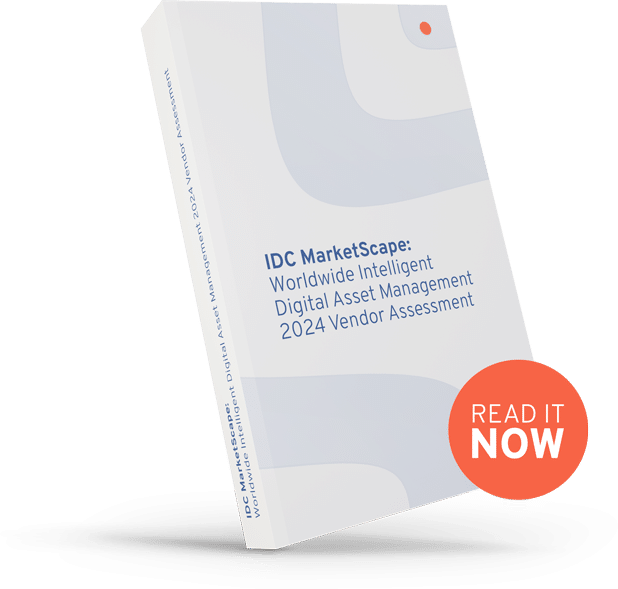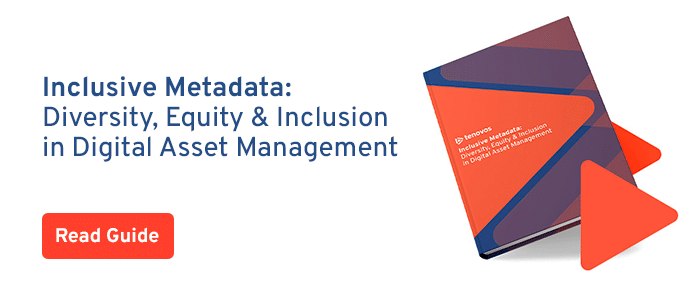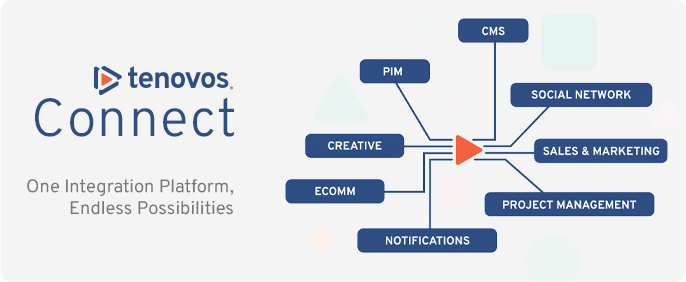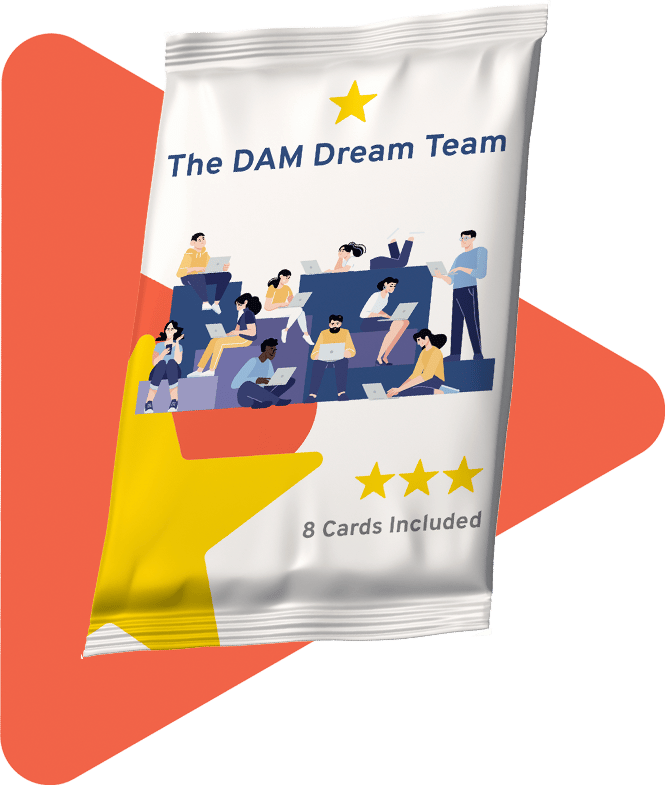
Last year we helped you understand who should be on your DAM Dream Team (Yes, like the 1992 United States Olympic team!). But when it comes to your digital asset management system (DAM) and the people you’ll hire to implement, manage, and optimize it, you’ll need more than just an internal team of high-scorers—you’ll need to recruit a few folks from outside your walls to achieve gold-medal goals.
That’s why we asked DAM Specialist and Consultant Kristina Huddart to weigh in on hiring and recruiting everyone you need to run a successful digital asset management system. Some will be from within your organization, others will come on for temporary projects or as consultants to support various stages of your DAM journey.
In this article, we’ll explain the skills required for each role, one “x-factor” each role needs to stand out, and some interview questions you can ask to get the right fit. If you want to know what makes each of these folks first draft picks for your dream team, you should definitely read part one in this series. Your own dream team is waiting, here’s how to get them onto the court.
- The Originator: Business Sponsor
- The Gatherer: Business Analyst
- The Secret Weapon: DAM Specialist
- The MVPs: DAM Manager (and soon, DAM Coordinators)
- The Tech Partner: DAM Vendor
- The Connector: DAM Integration Partner
- The Catalyzer: Change Manager
- The Generalist: IT Information Architect
The Originator:
Business Sponsor
It all begins with the business sponsor—the high-level executive who recognizes the gap that digital asset management could fill and advocates for the journey throughout. Oftentimes, they’re the chief marketing, digital, or information officer who recognizes the need to scale up their marketing operation or personalize content at scale. Ideally, the staff who first hear specific needs or problems which could be solved with DAM would escalate to the executive who sees the value of DAM and chooses to champion it as the business sponsor.
It’s from the business sponsor that the funding and support for the DAM dream team originate. Think of them like the manager of your all-star NBA team—they have the final say on your players, the budget, and long-term strategy.
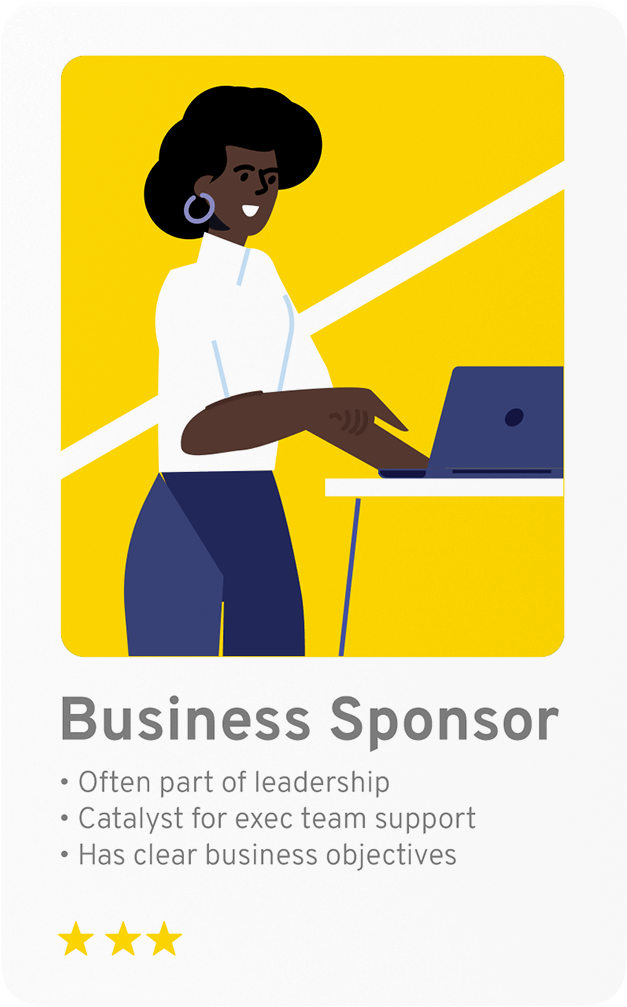
Skills Required
- Established influence: They are an internal voice who is well-respected among execs. During a business sponsor transition, the current DAM manager and DAM specialist would take great care to impart the importance of the business sponsors’ support to the team.
- Strategic thinking: They understand the scope of the project and are willing to commit to long-term relationship building with external vendors, consultants, and incoming DAM managers. They know that DAM is more than just technology and support a holistic DAM practice considering the right technology, people, process, and metadata.
- Business-savvy: They are aware of the limitations of the organization to support the DAM system, the budget constraints, and organizational goals, and consider the team’s capacity needs.
X-Factor: Passion
A passionate business sponsor is a successful one. They need to see the value of exploring a DAM (or supporting the current one) in achieving the business’ wider goals. If they’re passionate about the productivity gains, robust rights management, and creative workflow improvements the DAM provides, they will be inclined to support the dream team with whatever they need.
Interview questions
The business sponsor is the one who asks the questions and will be hiring and recruiting the entire dream team. But in the case of a transition, where a DAM manager and specialist are discussing the role of the business sponsor to an incumbent leader, here are some questions to ask:
- What is your experience and understanding of DAM systems? Are you excited about learning more about the DAM space and technology?
- Could we host a DAM demo to walk you through the current structure and discuss the future strategic plan of the DAM?
- What is your strategic vision for content management, creative production, and marketing operations?
- Are you willing to advocate on behalf of the team for our needs (budget, capacity needs, IT support, etc.)? How can we support you in doing so?
The Gatherer: Business Analyst
The first person the business sponsor brings onto the team is the business analyst. That’s because the business analyst’s role is to understand the current problems, collect information, and begin thinking about solutions. Kristina suggests the business sponsor recruit an analyst from their internal IT team, “The analyst will conduct research, host workshops, and lead interviews with stakeholders across the organization. It’s best if they already have relationships with stakeholders and a good understanding of the business needs.”
It’s important not to skip adding this member to your DAM dream team—whether you’re starting from scratch or replacing a current system. If you skip that business analysis phase, it can lead to spending a lot of time and money on something that isn’t going to solve the root cause of your problems.
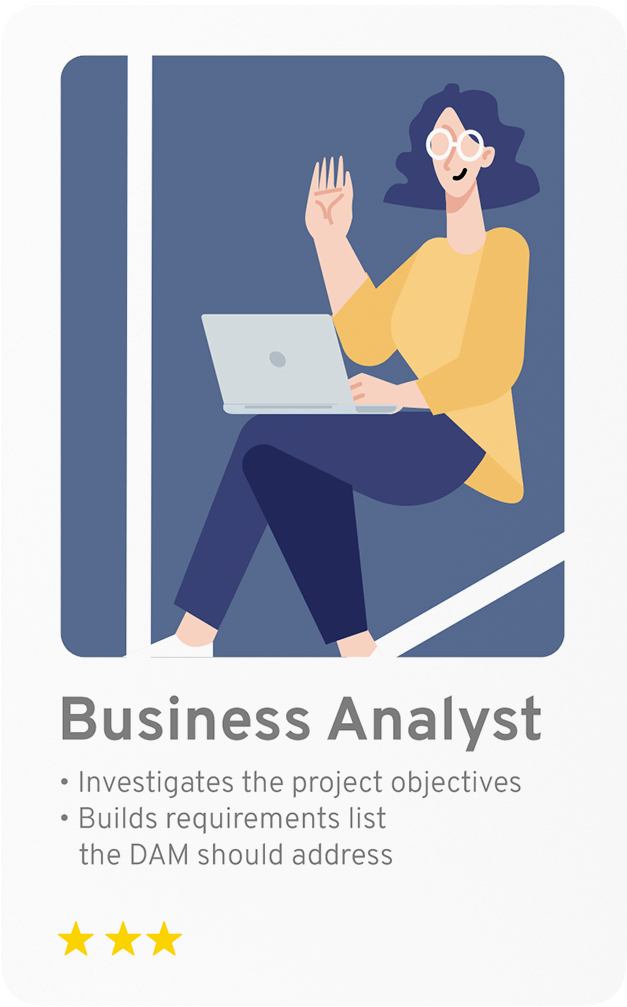
Skills Required
- Analytical, detail-driven: They skillfully collect, collate, and interpret stakeholder feedback, business requirements, and current processes into distinct pain points.
- People-savvy: They host workshops, conduct interviews, manage stakeholders expectations, and understand their needs.
- Forward-thinking, strategic: They analyze the current issues and requirements and envision the people, technology, and support needed to implement their recommended solutions. If they had the right tech or the right people in place, how could those changes improve processes moving forward?
- IT awareness: They understand your organization’s IT strategy and guide conversations and recommendations towards your IT requirements.
X-Factor: Change Management Skills
Your dream business analyst has a mix of analytical and people-driven skills. They are the first person most stakeholders will voice their concerns to. This also means they are the first agent of the change management process. They should understand the importance of their role in kicking off potential change and be skilled enough to give stakeholders reasonable expectations of what’s to come.
Kristina warns incumbent business analysts to avoid getting caught up in people’s assumptions and excitement while they’re collecting information. “Analysts often get stakeholders saying things like, “You’re asking me about my pain points. Is that because we’re going to get something better? How are you going to improve things for me?” Your business analyst should be empowered to share the businesses sponsors’ goals for this data collection process without over-promising on solutions.”
Interview questions
- This data collection phase will be on a temporary project basis. How much of your time can you devote to this project? Are you able to hand it off to the DAM specialist and/or manager once it’s complete?
- Would you consider yourself a people-person? How comfortable are you with conducting interviews, hosting workshops, and public speaking?
- Are you excited about collecting qualitative and quantitative data? Organizing it, analyzing it, documenting it, and drawing conclusions?
The Secret Weapon: DAM Specialist
Your DAM dream team isn’t complete without a specialist. They will serve as the mentor, educator, and industry specialist every DAM team needs at different stages of their journey. They’re usually brought on by the business sponsor to take the requirements that the business analyst unearthed and help the organization find the right solutions to solve their problems.
According to Kristina, it’s best to recruit for this role externally. The DAM marketplace has dozens of vendors, lots of different solutions, and best practices are different depending on use cases. The DAM specialist has a breadth of experience across sectors, and they know how to match companies to the right solutions, recruit and train the right folks, and guide the plan for this new change and optimizing the DAM.
And among the most important tasks, the specialist should be involved in hiring the DAM manager—who is best added to the dream team shortly after the specialist joins. The specialist will work alongside the manager to help them upskill and fill any gaps in their knowledge as the team grows. Since the specialist is usually an external consultant, they can stay on as ongoing support or just for certain stages of the DAM journey as it evolves.
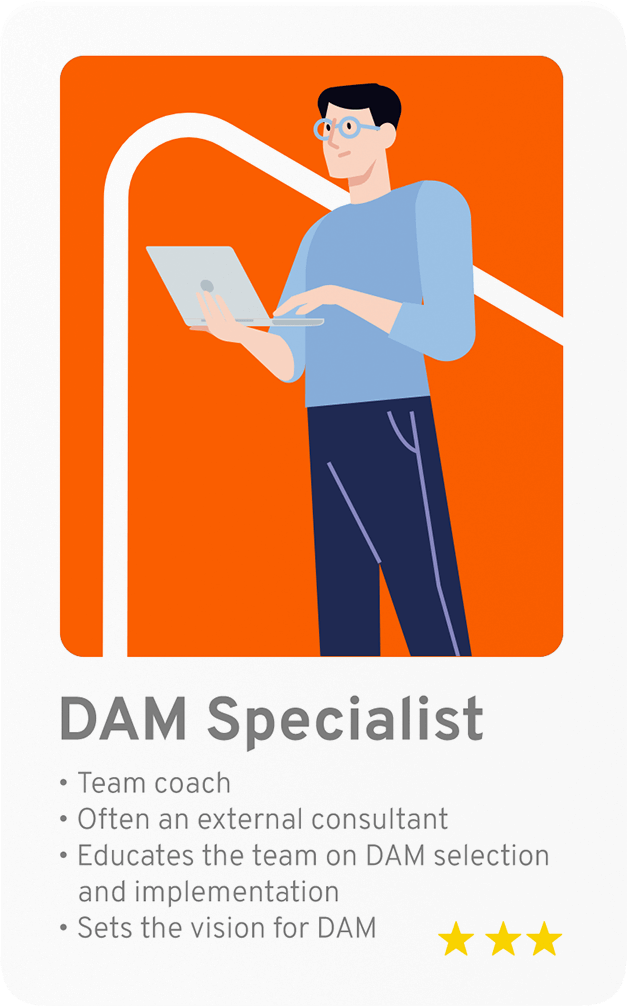
Skills Required
- Mentor, educator mindset: They prioritize sharing their DAM knowledge with the dream team. They help select the right vendor, support implementation processes, train on best practices, recruit new team members, and upskill members of the team.
- Well-respected and connected: They have experience across sectors, working with multiple vendors, and organizations large and small. They connect your team with the clients of potential vendors so they can understand how the product really works. They can connect the business sponsor with other executives in the same field to share their experience supporting the DAM journey.
- Focused and visionary: The specialist builds the documentation, processes, and best practices that will help keep the DAM working smoothly. They support strategic and business goals by offering insights and recommendations into how your organization’s DAM practice can improve now and in the future.
- Breadth of experience: They’ve built relationships across sectors like corporate, NGOs, and startups. They know what competitors are doing but also the unique challenges they’ve faced allow them to recommend unique solutions. They know how to transfer ideas from other spaces to help your organization improve processes.
X-Factor: Connections
The magic words you want to hear when hiring your dream specialist are, “We’re in this together. I’ve got connections to the best vendors for your industry. I can help you get the right demos and introduce you to your peers in the industry so you can see how DAM works for them.”
Beyond the knowledge of the DAM marketplace, the conversations that a great specialist can facilitate are invaluable. Kristina often invites her clients to meet with other C-suite business sponsors or DAM managers in the same industry. Those open and honest conversations help teams understand how DAM might be embedded into their organizations. These connections also assist teams in building community, recruiting future team members, and keeping up as technology evolves.
“For a specialist, having the right network and being well-respected in the industry is so important—it’s such a close-knit community,” Kristina says. “We know what works and we learn from each other’s mistakes. If you can find a DAM specialist like that, you’re golden.”
Interview questions
- What approach would you take to help us evaluate our level of DAM maturity and build a roadmap for optimizing our DAM practice to achieve our business objectives?
- What are the key factors that help companies across industries to ensure long-term success with DAM? Give some examples from clients you have worked with of what a successful DAM practice looks like.
- How can you help us to take the reins of our DAM practice and hire the right team of people for our future success?
- What is your experience with educating and upskilling resources in DAM?
- What is your experience influencing executives to get buy-in for DAM?
“If you’re looking to hire a DAM specialist for a vendor selection process, then you want someone who knows the landscape and understands how to pick the right platform. But if you’re looking for someone to help you to build out your metadata and taxonomy structure, that’s a very different skill set. Shift your interview questions accordingly.”
– Kristina Huddart
The MVPs: DAM Manager (and soon, DAM Coordinators)
One of the most important members of your dream team—arguably your MVP—is your DAM manager. Once you’ve recruited a stellar specialist, now’s the perfect time to scout out a manager who will carry this journey forward. Keep in mind that DAM managers should be full-time, dedicated, permanent roles and shouldn’t be shared with other business functions.
In an ideal world, your incumbent manager already has some DAM experience under their belt. A few years of experience working in DAM already, DAM-specific courses taken, a certification, or degree in a related field like library sciences. But oftentimes, a manager is plucked from within your organization—they might be a star on the marketing team or someone in IT who is always trying to improve processes. In this circumstance, the manager is unlikely to have DAM knowledge. But fret not, as long as your DAM specialist can help them upskill and learn on the job before they’re left to take care of it all by themselves, hiring a DAM manager (and later coordinators) from within the organization can be a great way to grow the team.
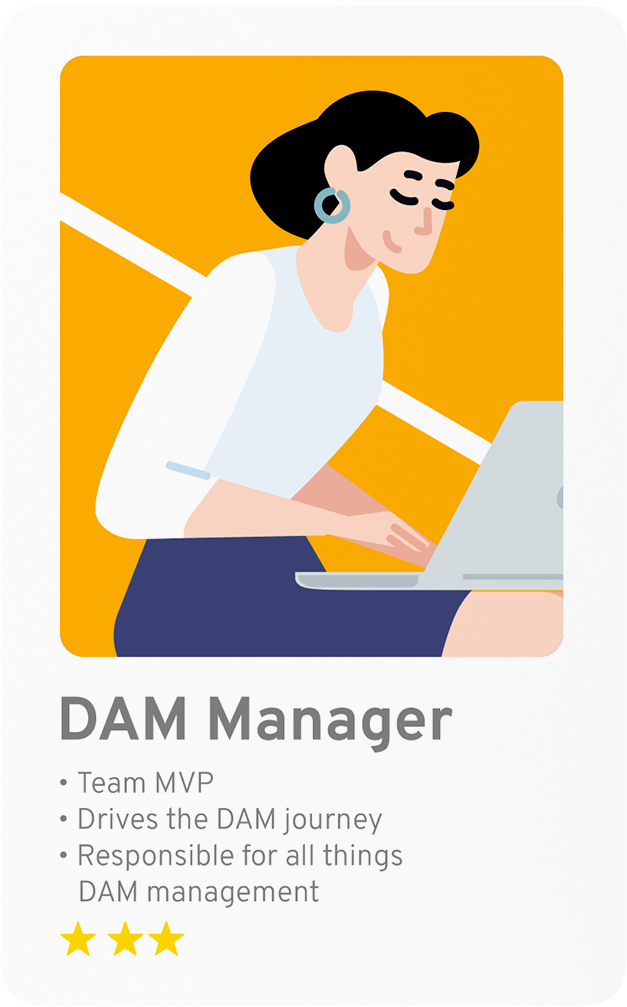
In the case of DAM coordinators, they are usually brought on when the system becomes too untenable for a single manager. As more assets come into the system, more users need training and onboarding, and as the system is rolled out to more departments, the manager is very quickly going to reach out for support. At this point, the manager would take on a strategic and advisory role while the coordinators execute the daily operations. It’s important for the business sponsor to be connected with their DAM manager and keep their capacity in mind as the use cases, users, volume of assets, and business requirements grow.
As your organization is developing the foundations of the DAM, the coordinator takes on the daily administrative tasks of the DAM, while the manager handles the strategic ones. Some companies will even move from having their own internal coordinators to working with a third-party DAM-managed services company. Whether you hire and recruit coordinators or choose a third-party provider, your dream team will eventually require several coordinators to use your system to its full potential (and avoid burning out your DAM manager).
Skills Required: DAM Manager
- Growth mindset: They pick up new things quickly and are willing to learn outside of their role. Great managers are curious, constantly learning, and interested in finding the connections between new tech and the DAM. They could also have previous experience in DAM systems, have taken courses, or have an understanding of best practices.
- Problem-solving: They have the skills of a senior-level project manager. They’re driving the journey and helping to grow the best practices over time. They are running reports, analyzing data, and going to the business sponsor with their findings and ideas.
- Creativity: A great manager is excited to get their hands on the DAM systems and is willing to experiment. They are creatively considering all the ways it can be improved and better embedded in the business. They are gathering requirements for new use cases and trying to understand what it would take to implement them.
- Passionate about change: If you don’t hire or have a change manager in your organization, you need a manager with great communication skills who can create and execute an effective change management plan, especially during the adoption phase.
Skills Required: DAM Coordinator
- Excited by data and “tedious” tasks: They are energized by daily administrative tasks. They manage the uploads and ensure metadata quality stays up to standard. They are detail-oriented and passionate about data accuracy because they do a lot of data entry, data management, and quality control.
- Healthy fear of rights management: They’re the person that internal teams go to to understand the rights of assets and what they can do with them. They should have enough of an understanding of rights management that they’d never copy and paste assets from Google Images *shudder* and they can guide users through the maze of rights management metadata.
- Analytical, tech-savvy: The coordinator runs reports regularly, pulling analytics and user behavior to share with the manager. They have an understanding of how to contextualize that data and share it—how will the changes and improvements they make in the DAM make affect the experience of those using it? They’re always thinking about how to improve systems.
- Customer service-minded: The coordinator provides access, regular training, and onboarding for all users. They get a lot of technical questions and they’re friendly and patient as they help users resolve issues.
X-Factor: Ability to Build Long-Term Relationships
A standout DAM manager is able to build long-term relationships—not only with executive-level folks like the business sponsor, but also with other leaders, internal stakeholders, and users. Their internal relationships will set the foundation for a years-long DAM journey that will touch functions across the business. If a manager can prove they have facilitated collaboration across functions and maintained positive relationships with executives and users alike, they are someone special.
Similarly, the manager’s relationship with the vendor is likely the longest and most important one they’ll build (or inherit). Having a trusted, productive relationship allows processes like implementing new integrations or suggesting new use cases smoother. “They should be confident enough to call the vendor and say, ‘Hey, we’ve got a new use case. How do I do this?’ And get the answers and support they need,” Kristina says.
Interview questions: For the DAM Manager
- What do you know about digital asset management? Where have you gained your knowledge and experience?
- Do you learn quickly and enjoy picking up new skills?
- What are some common use cases/problems that DAM can solve? How would you handle stakeholders coming to you with new use cases to implement?
- How are you broadening your DAM knowledge right now? What are trends you’re noticing in the industry?
- What’s your experience with change management?
- How would you guide a resistant stakeholder to adopting a new way of working?
Interview questions: For the DAM Coordinator
- What do you know about digital asset management? Where have you gained your knowledge and experience?
- Do you enjoy working with excel spreadsheets and reviewing data? How would you manage a metadata audit?
- Describe how you QC (quality control) metadata?
- What’s your level of understanding of rights management in our industry
- Would you consider yourself a people-person? Why or why not? Do you have experience in customer service?
- What would you do if you discover a process or workflow is not working well for your users?
The Tech Partner: DAM Vendor
The average enterprise company is juggling 843 individual applications across their tech stack. And as any operations professional or IT team will tell you, most companies don’t use their tech stack to its full potential. When a company is investing in a big foundational tool like DAM, they’re not usually considering any functionality beyond the basic use cases. “There’s so much more DAM can do. That’s why picking the right vendor—and developing a close relationship with them—is so important,” Kristina says.
You’re looking for a partner. A vendor that will prioritize evolving functionalities, new use cases, and listening to your businesses needs. The selection process is complex (and that’s where your specialist’s knowledge comes in handy) but there are a few things to look out for while scouting for a vendor. “I’m always looking for vendors who step up and help their customers make the most out of their tools. I evaluate whether vendors are able to get organizations to that next level and help them mature their DAM practices,” Kristina explains.
One way to understand the experience of working with a potential vendor is to ask your specialist to set up calls with managers and executive peers who are using vendors you’re interested in. Get their real feedback about their experiences and tap into your specialist’s network to do it.
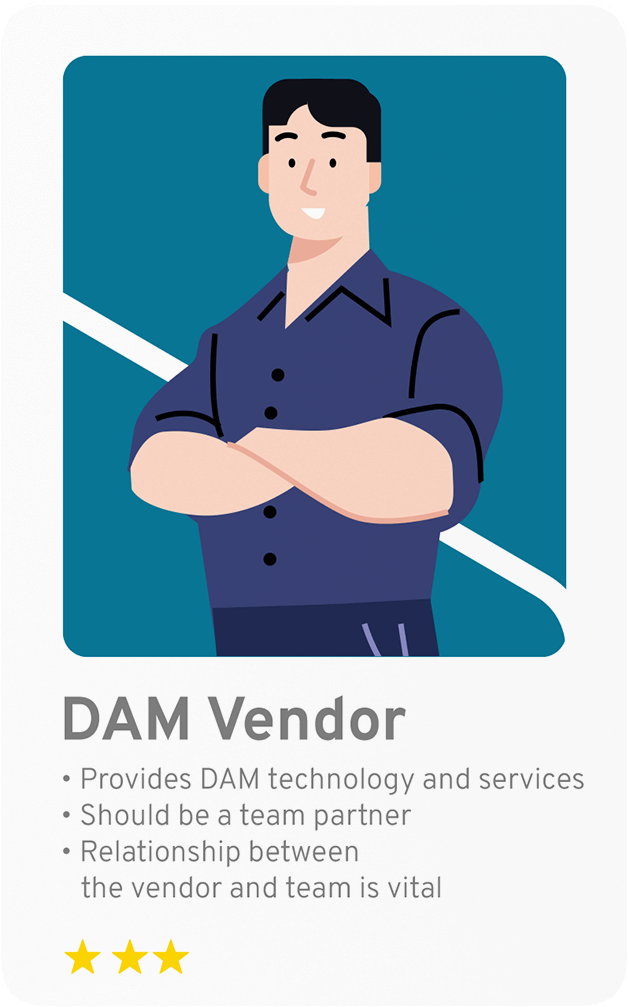
Skills Required
- Fulfills your business and technical requirements: The vendor is able to fulfill the requirements and use cases set out by the specialist and manager. This vendor has the people, processes, and tech capabilities that meet your request for proposal (RFP).
- Responsive customer service: The vendor’s customer support team is robust and able to handle requests promptly. Their customer success team is knowledgeable and willing to help.
- Prioritizes innovation: They provide innovation and development roadmaps for potential clients and are open and honest about the future of their platform and technology. They are developing at a speed that keeps pace with the industry and the needs of their clients. They will be the right fit now and in three and five years because they’re releasing new use cases and features and thinking long term.
- Willingness to develop partnership: Even if they don’t tick every single technical box, they’re willing to put the work in and communicate with their clients along the way. For example, their executives are willing to have open conversations with the executives of potential clients to talk about how to position their DAM for digital transformation and marketing operations.
X-Factor: Change Management Skills
A stellar vendor will have many high-value, satisfied users that have been working in DAM for years. Kristina recommends looking out for the vendors who host yearly client forums to bring those users together. These in-person (and increasingly online) events organized by vendors are a treasure trove of community, knowledge sharing, and connection. “They’re problem-solving for a year’s worth of frustrations,” Kristina says. “It’s an opportunity for clients to share and learn from one another.”
These events not only only give the clients a chance to talk to each other, but they also give the vendor a chance to listen. Vendors use those forums to learn how their clients are using their tool right now and what functionalities they want to see in the future. And great vendors are acting on those insights to launch new features, use cases, and design their roadmaps.
Also, keep an eye out for vendors who host regular client webinars to share their client stories and best practices. Vendors don’t have to host yearly Salesforce-esque extravaganzas to bring together their community.
Interview questions
- What’s your customer service/support system? What are your average response times?
- Do you meet our business and technical requirements? How are you looking to meet those in the future if we select you?
- What are your development roadmaps for this year? Next year? What are your innovation goals for five and ten years from now?
- Can our leadership meet with yours? Can you connect us with DAM managers who are working in your system already and who can share their experience?
- Do you offer ways for your clients to interact with one another? Yearly client forums, webinars, or Slack communities?
The Connector: DAM Integration Partner
If you’ve selected your dream vendor, you’re likely in the middle of connecting your new platform to the rest of your stack. This is where a DAM integration partner comes in. An integration partner supports your team in connecting your DAM to your desired platforms. Whether that’s connecting with a PIM, content marketing software (CMS), or content delivery network (CDN).
The key to hiring the right integration partner is to work with someone who has done that integration before—if you’re looking to connect your DAM to an existing CMS, hire someone with experience integrating those specific platforms. Depending on the integration you may need one developer or a team. And you might end up working with different integration partners for different integrations. Kristina suggests connecting with your vendor for their suggestions and recommended partners.
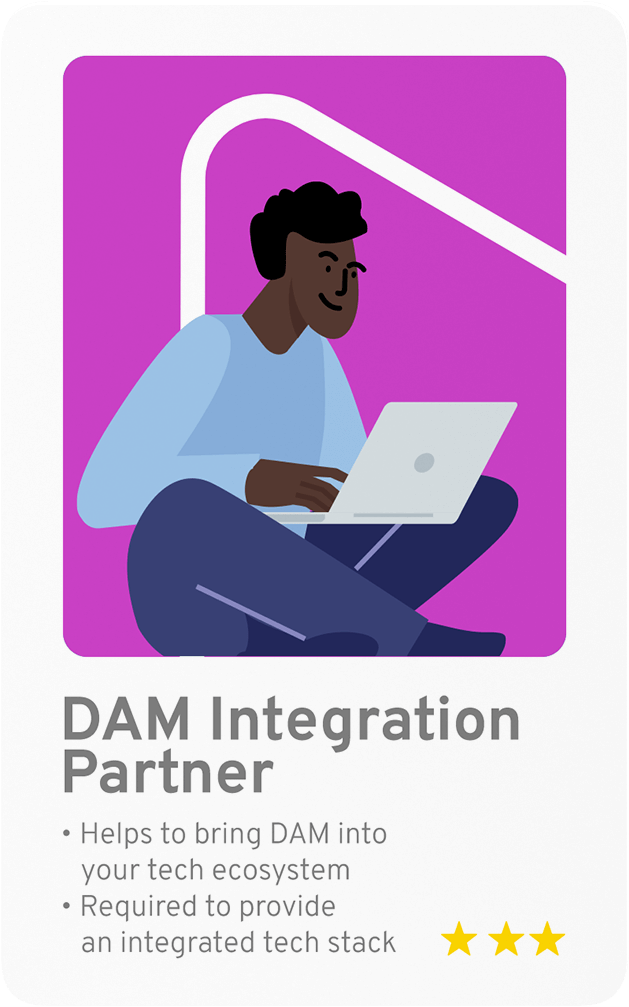
Skills Required
- Recommended by vendor: They are an integration partner that is familiar with your DAM system and they come recommended by your vendor.
- Experience with desired integration: They have worked to implement the integrations you desire. They may be skilled at the integration between DAM and PIM, and you may choose a different integration partner for DAM and CMS.
X-Factor: Orchestration of Content and Data
The role of integration partners is to facilitate the flow of content and data from one system to another. Done seamlessly, your end users will barely notice they are switching tools or that content is being handed off. Give them a full overview of your processes—with the knowledge of your end-to-end digital asset lifecycle, they have the skills to ensure the right content and data flows automatically through your processes. They may also have IT specialists on their teams to support your integration needs.
If you’re not sure what an ideal end-to-end digital asset lifecycle should look like in an integrated ecosystem, bring your DAM specialist back to function as a liaison between end users and the integration partner.
Interview questions
- What is your experience with the integration(s) we’re planning to implement? What support do you offer throughout the integration process?
- What is your experience with the vendor?
- What resources would you allocate to this project? (Number of developers, IT specialists, hours, etc.)
- How will you hand off integration management and maintenance to our in-house teams?
The Catalyzer: Change Manager
If we’re talking about your dream team, Kristina says that a change manager should be your first draft pick. Since DAM sits as a foundational piece within the whole marketing tech stack, their support early on is pivotal. A change manager understands how to best implement new processes so there’s minimal disruption to the business. Whether that’s improving onboarding processes or managing big cultural shifts, they work across the tech stack and asset lifecycle.
As a DAM specialist, Kristina is also brought on to offer her change management skills on a temporary basis. But she warns that, as helpful as specialists and DAM managers can be in the change management process, they shouldn’t be tasked to do it all. “I often see the DAM manager and change manager smooshed together, but in a dream team, they’d be separate roles working together to carry the change into the future,” she says.
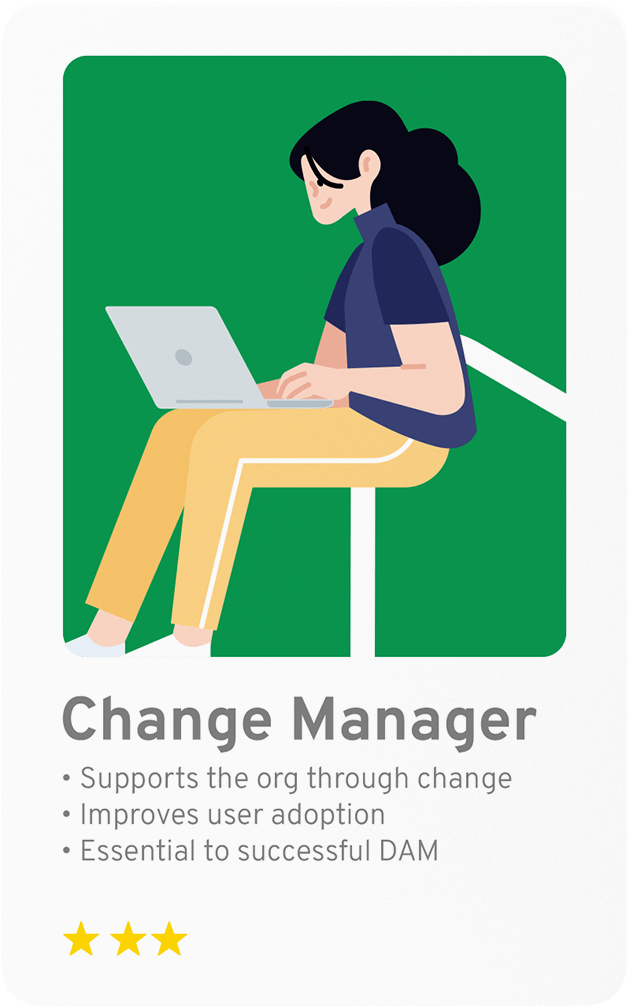
Skills Required
- Impeccable people skills: They are incredibly charismatic, thoughtful, and patient. They love talking to people and solving the problems that are bothering them. They are most at home in groups, collaboration, and conversation.
- Passionate about education: The change manager is a great teacher, trainer, and mentor. They get early adopters excited and help coax the stragglers on board too.
- Process-oriented: They are well-organized and always thinking about how to improve processes. The change manager recognizes the challenge of managing change at scale and they are focused on understanding all the risks and roadblocks that may arise in the journey.
- Top-notch communication skills: They are phenomenal communicators and even better listeners. They can empathize with anyone and mediate conflicts with ease and skill.
- Trusted and influential: Whether they’re an external consultant or internal change managers, they are trusted by their peers. They know how to work with people resistant to change and juggle the human emotions associated with change. They know that developing and maintaining relationships across the business are key components to implementing and sustaining change.
X-Factor: Tech-Savvy
Your dream change manager doesn’t need DAM experience, but it’s valuable. Often the specialist can help upskill them. They should be open to new technology, willing to learn (being an early adopter themselves is ideal), and be confident to turn around and teach others.
Interview questions
- Describe situations where you have built and executed change management plans within a business. What challenges did you face and how did you overcome them?
- How do you get buy-in from all levels of stakeholders?
- Do you enjoy facilitating training and mentorship? Describe your coaching techniques.
- How do you manage conflict and resistance to change in the workplace? Walk us through your process.
- How would you rate your communication and listening skills (from 1-10) Why?
The Generalist: IT Information Architect
The business sponsor should go to their IT team and recruit this role at the start of your DAM journey, especially to offer their insights to the business analyst and DAM specialist. They could be added to the team on a temporary basis to work on a particular stage of the journey (often during initial implementation and future integrations) or devote a percentage of their time to DAM-related projects.
They are embedded in the business and have deep knowledge of your tech stack, how data currently flows, and the wider IT goals the DAM should adhere to. Request their support while implementing the software, working through integration processes with your vendor, and integration partners, or when new use cases arise.
You may also choose to bring on external IT consultants or specialists when the scope of a DAM project is outside the skills of your internal team.
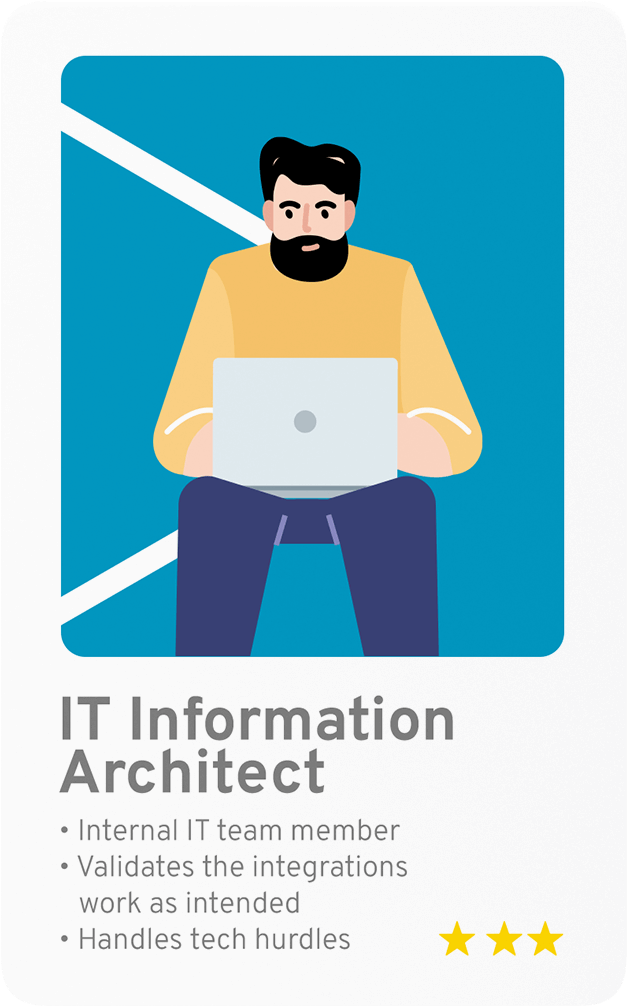
Skills Required
- Knowledge of your existing tech ecosystem: They are embedded in your IT team and your technical architecture. They understand your organization’s goals, how data is collected, and how information flows.
- DAM experience: Ideally they have some DAM experience and understand how the system and data is different from other platforms in your marketing stack.
X-Factor: User-Centric Focus
While your typical information architect is thinking about how content will flow through a complex tech stack, a great information architect truly understands users and prioritizes their needs. Great architects will be supremely focused on how changes to your systems affect user experience and how the addition of the DAM fits into the puzzle of your tech stack.
Interview questions
- What is your technical experience with DAM? Are you willing to learn on the job?
- Can you envision how the DAM will work in our current tech stack? What are the challenges you see arising from that change?
- Are you willing to support this project on a temporary basis? Or devote a percentage of your capacity to support the DAM on an ongoing basis?
If Your DAM Team is Just a Dream, Upskill Them
Your dream is to have a team filled with people who are skilled with DAM. The reality is often quite different, and Kristina is here to assure you that’s perfectly okay: “In reality, your team can have people who don’t have any DAM experience. The key to success is prioritizing hiring folks with a learning mindset—people who are curious and want to grow their knowledge.”
Your dream team should be filled with people who love problem-solving and have the desire to replace the sentence “I don’t know” with “I don’t know yet, but we’re gonna find out.” Those folks can take advantage of the myriad ways to upskill. Conferences, webinars, and courses (see resources below) offer regular educational opportunities to learn DAM best practices.
Kristina’s most important team-building advice is to keep that learning mindset going as technology and DAM best practice evolves. “Keep upskilling your team. The digital industry is moving quickly, so send your DAM manager to the vendor-client forums and conferences. Give them the opportunities to learn and bring that knowledge back to your organization.” It’s never too late to get your dream team off the bench and onto the court.
- The Originator: Business Sponsor
- The Gatherer: Business Analyst
- The Secret Weapon: DAM Specialist
- The MVPs: DAM Manager (and soon, DAM Coordinators)
- The Tech Partner: DAM Vendor
- The Connector: DAM Integration Partner
- The Catalyzer: Change Manager
- The Generalist: IT Information Architect
The Originator:
Business Sponsor
It all begins with the business sponsor—the high-level executive who recognizes the gap that digital asset management could fill and advocates for the journey throughout. Oftentimes, they’re the chief marketing, digital, or information officer who recognizes the need to scale up their marketing operation or personalize content at scale. Ideally, the staff who first hear specific needs or problems which could be solved with DAM would escalate to the executive who sees the value of DAM and chooses to champion it as the business sponsor.
It’s from the business sponsor that the funding and support for the DAM dream team originate. Think of them like the manager of your all-star NBA team—they have the final say on your players, the budget, and long-term strategy

Skills Required
- Established influence: They are an internal voice who is well-respected among execs. During a business sponsor transition, the current DAM manager and DAM specialist would take great care to impart the importance of the business sponsors’ support to the team.
- Strategic thinking: They understand the scope of the project and are willing to commit to long-term relationship building with external vendors, consultants, and incoming DAM managers. They know that DAM is more than just technology and support a holistic DAM practice considering the right technology, people, process, and metadata.
- Business-savvy: They are aware of the limitations of the organization to support the DAM system, the budget constraints, and organizational goals, and consider the team’s capacity needs.
X-Factor: Passion
A passionate business sponsor is a successful one. They need to see the value of exploring a DAM (or supporting the current one) in achieving the business’ wider goals. If they’re passionate about the productivity gains, robust rights management, and creative workflow improvements the DAM provides, they will be inclined to support the dream team with whatever they need.
Interview questions
The business sponsor is the one who asks the questions and will be hiring and recruiting the entire dream team. But in the case of a transition, where a DAM manager and specialist are discussing the role of the business sponsor to an incumbent leader, here are some questions to ask:
- What is your experience and understanding of DAM systems? Are you excited about learning more about the DAM space and technology?
- Could we host a DAM demo to walk you through the current structure and discuss the future strategic plan of the DAM?
- What is your strategic vision for content management, creative production, and marketing operations?
- Are you willing to advocate on behalf of the team for our needs (budget, capacity needs, IT support, etc.)? How can we support you in doing so?
The Gatherer: Business Analyst
The first person the business sponsor brings onto the team is the business analyst. That’s because the business analyst’s role is to understand the current problems, collect information, and begin thinking about solutions. Kristina suggests the business sponsor recruit an analyst from their internal IT team, “The analyst will conduct research, host workshops, and lead interviews with stakeholders across the organization. It’s best if they already have relationships with stakeholders and a good understanding of the business needs.”
It’s important not to skip adding this member to your DAM dream team—whether you’re starting from scratch or replacing a current system. If you skip that business analysis phase, it can lead to spending a lot of time and money on something that isn’t going to solve the root cause of your problems.

Skills Required
- Analytical, detail-driven: They skillfully collect, collate, and interpret stakeholder feedback, business requirements, and current processes into distinct pain points.
- People-savvy: They host workshops, conduct interviews, manage stakeholders expectations, and understand their needs.
- Forward-thinking, strategic: They analyze the current issues and requirements and envision the people, technology, and support needed to implement their recommended solutions. If they had the right tech or the right people in place, how could those changes improve processes moving forward?
- IT awareness: They understand your organization’s IT strategy and guide conversations and recommendations towards your IT requirements.
X-Factor: Change Management Skills
Your dream business analyst has a mix of analytical and people-driven skills. They are the first person most stakeholders will voice their concerns to. This also means they are the first agent of the change management process. They should understand the importance of their role in kicking off potential change and be skilled enough to give stakeholders reasonable expectations of what’s to come.
Kristina warns incumbent business analysts to avoid getting caught up in people’s assumptions and excitement while they’re collecting information. “Analysts often get stakeholders saying things like, “You’re asking me about my pain points. Is that because we’re going to get something better? How are you going to improve things for me?” Your business analyst should be empowered to share the businesses sponsors’ goals for this data collection process without over-promising on solutions.”
Interview questions
- This data collection phase will be on a temporary project basis. How much of your time can you devote to this project? Are you able to hand it off to the DAM specialist and/or manager once it’s complete?
- Would you consider yourself a people-person? How comfortable are you with conducting interviews, hosting workshops, and public speaking?
- Are you excited about collecting qualitative and quantitative data? Organizing it, analyzing it, documenting it, and drawing conclusions?
The Secret Weapon: DAM Specialist
Your DAM dream team isn’t complete without a specialist. They will serve as the mentor, educator, and industry specialist every DAM team needs at different stages of their journey. They’re usually brought on by the business sponsor to take the requirements that the business analyst unearthed and help the organization find the right solutions to solve their problems.
According to Kristina, it’s best to recruit for this role externally. The DAM marketplace has dozens of vendors, lots of different solutions, and best practices are different depending on use cases. The DAM specialist has a breadth of experience across sectors, and they know how to match companies to the right solutions, recruit and train the right folks, and guide the plan for this new change and optimizing the DAM.
And among the most important tasks, the specialist should be involved in hiring the DAM manager—who is best added to the dream team shortly after the specialist joins. The specialist will work alongside the manager to help them upskill and fill any gaps in their knowledge as the team grows. Since the specialist is usually an external consultant, they can stay on as ongoing support or just for certain stages of the DAM journey as it evolves.

Skills Required
- Mentor, educator mindset: They prioritize sharing their DAM knowledge with the dream team. They help select the right vendor, support implementation processes, train on best practices, recruit new team members, and upskill members of the team.
- Well-respected and connected: They have experience across sectors, working with multiple vendors, and organizations large and small. They connect your team with the clients of potential vendors so they can understand how the product really works. They can connect the business sponsor with other executives in the same field to share their experience supporting the DAM journey.
- Focused and visionary: The specialist builds the documentation, processes, and best practices that will help keep the DAM working smoothly. They support strategic and business goals by offering insights and recommendations into how your organization’s DAM practice can improve now and in the future.
- Breadth of experience: They’ve built relationships across sectors like corporate, NGOs, and startups. They know what competitors are doing but also the unique challenges they’ve faced allow them to recommend unique solutions. They know how to transfer ideas from other spaces to help your organization improve processes.
X-Factor: Connections
The magic words you want to hear when hiring your dream specialist are, “We’re in this together. I’ve got connections to the best vendors for your industry. I can help you get the right demos and introduce you to your peers in the industry so you can see how DAM works for them.”
Beyond the knowledge of the DAM marketplace, the conversations that a great specialist can facilitate are invaluable. Kristina often invites her clients to meet with other C-suite business sponsors or DAM managers in the same industry. Those open and honest conversations help teams understand how DAM might be embedded into their organizations. These connections also assist teams in building community, recruiting future team members, and keeping up as technology evolves.
“For a specialist, having the right network and being well-respected in the industry is so important—it’s such a close-knit community,” Kristina says. “We know what works and we learn from each other’s mistakes. If you can find a DAM specialist like that, you’re golden.”
Interview questions
- What approach would you take to help us evaluate our level of DAM maturity and build a roadmap for optimizing our DAM practice to achieve our business objectives?
- What are the key factors that help companies across industries to ensure long-term success with DAM? Give some examples from clients you have worked with of what a successful DAM practice looks like.
- How can you help us to take the reins of our DAM practice and hire the right team of people for our future success?
- What is your experience with educating and upskilling resources in DAM?
- What is your experience influencing executives to get buy-in for DAM?
“If you’re looking to hire a DAM specialist for a vendor selection process, then you want someone who knows the landscape and understands how to pick the right platform. But if you’re looking for someone to help you to build out your metadata and taxonomy structure, that’s a very different skill set. Shift your interview questions accordingly.”– Kristina Huddart
The MVPs: DAM Manager (and soon, DAM Coordinators)
One of the most important members of your dream team—arguably your MVP—is your DAM manager. Once you’ve recruited a stellar specialist, now’s the perfect time to scout out a manager who will carry this journey forward. Keep in mind that DAM managers should be full-time, dedicated, permanent roles and shouldn’t be shared with other business functions.
In an ideal world, your incumbent manager already has some DAM experience under their belt. A few years of experience working in DAM already, DAM-specific courses taken, a certification, or degree in a related field like library sciences. But oftentimes, a manager is plucked from within your organization—they might be a star on the marketing team or someone in IT who is always trying to improve processes. In this circumstance, the manager is unlikely to have DAM knowledge. But fret not, as long as your DAM specialist can help them upskill and learn on the job before they’re left to take care of it all by themselves, hiring a DAM manager (and later coordinators) from within the organization can be a great way to grow the team.

In the case of DAM coordinators, they are usually brought on when the system becomes too untenable for a single manager. As more assets come into the system, more users need training and onboarding, and as the system is rolled out to more departments, the manager is very quickly going to reach out for support. At this point, the manager would take on a strategic and advisory role while the coordinators execute the daily operations. It’s important for the business sponsor to be connected with their DAM manager and keep their capacity in mind as the use cases, users, volume of assets, and business requirements grow.
As your organization is developing the foundations of the DAM, the coordinator takes on the daily administrative tasks of the DAM, while the manager handles the strategic ones. Some companies will even move from having their own internal coordinators to working with a third-party DAM-managed services company. Whether you hire and recruit coordinators or choose a third-party provider, your dream team will eventually require several coordinators to use your system to its full potential (and avoid burning out your DAM manager).
Skills Required: DAM Manager
- Growth mindset: They pick up new things quickly and are willing to learn outside of their role. Great managers are curious, constantly learning, and interested in finding the connections between new tech and the DAM. They could also have previous experience in DAM systems, have taken courses, or have an understanding of best practices.
- Problem-solving: They have the skills of a senior-level project manager. They’re driving the journey and helping to grow the best practices over time. They are running reports, analyzing data, and going to the business sponsor with their findings and ideas.
- Creativity: A great manager is excited to get their hands on the DAM systems and is willing to experiment. They are creatively considering all the ways it can be improved and better embedded in the business. They are gathering requirements for new use cases and trying to understand what it would take to implement them.
- Passionate about change: If you don’t hire or have a change manager in your organization, you need a manager with great communication skills who can create and execute an effective change management plan, especially during the adoption phase.
Skills Required: DAM Coordinator
- Excited by data and “tedious” tasks: They are energized by daily administrative tasks. They manage the uploads and ensure metadata quality stays up to standard. They are detail-oriented and passionate about data accuracy because they do a lot of data entry, data management, and quality control.
- Healthy fear of rights management: They’re the person that internal teams go to understand the rights of assets and what they can do with them. They should have enough of an understanding of rights management that they’d never copy and paste assets from Google Images *shudder* and they can guide users through the maze of rights management metadata.
- Analytical, tech-savvy: The coordinator runs reports regularly, pulling analytics and user behavior to share with the manager. They have an understanding of how to contextualize that data and share it—how will the changes and improvements they make in the DAM make affect the experience of those using it? They’re always thinking about how to improve systems.
- Customer service-minded: The coordinator provides access, regular training, and onboarding for all users. They get a lot of technical questions and they’re friendly and patient as they help users resolve issues.
X-Factor: Ability to Build Long-Term Relationships
A standout DAM manager is able to build long-term relationships—not only with executive-level folks like the business sponsor, but also with other leaders, internal stakeholders, and users. Their internal relationships will set the foundation for a years-long DAM journey that will touch functions across the business. If a manager can prove they have facilitated collaboration across functions and maintained positive relationships with executives and users alike, they are someone special.
Similarly, the manager’s relationship with the vendor is likely the longest and most important one they’ll build (or inherit). Having a trusted, productive relationship allows processes like implementing new integrations or suggesting new use cases smoother. “They should be confident enough to call the vendor and say, ‘Hey, we’ve got a new use case. How do I do this?’ And get the answers and support they need,” Kristina says.
Interview questions: For the DAM Manager
- What do you know about digital asset management? Where have you gained your knowledge and experience?
- Do you learn quickly and enjoy picking up new skills?
- What are some common use cases/problems that DAM can solve? How would you handle stakeholders coming to you with new use cases to implement?
- How are you broadening your DAM knowledge right now? What are trends you’re noticing in the industry?
- What’s your experience with change management?
- How would you guide a resistant stakeholder to adopting a new way of working?
Interview questions: For the DAM Coordinator
- What do you know about digital asset management? Where have you gained your knowledge and experience?
- Do you enjoy working with excel spreadsheets and reviewing data? How would you manage a metadata audit?
- Describe how you QC (quality control) metadata?
- What’s your level of understanding of rights management in our industry
- Would you consider yourself a people-person? Why or why not? Do you have experience in customer service?
- What would you do if you discover a process or workflow is not working well for your users?
The Tech Partner: DAM Vendor
The average enterprise company is juggling 843 individual applications across their tech stack. And as any operations professional or IT team will tell you, most companies don’t use their tech stack to its full potential. When a company is investing in a big foundational tool like DAM, they’re not usually considering any functionality beyond the basic use cases. “There’s so much more DAM can do. That’s why picking the right vendor—and developing a close relationship with them—is so important,” Kristina says.
You’re looking for a partner. A vendor that will prioritize evolving functionalities, new use cases, and listening to your businesses needs. The selection process is complex (and that’s where your specialist’s knowledge comes in handy) but there are a few things to look out for while scouting for a vendor. “I’m always looking for vendors who step up and help their customers make the most out of their tools. I evaluate whether vendors are able to get organizations to that next level and help them mature their DAM practices,” Kristina explains.
One way to understand the experience of working with a potential vendor is to ask your specialist to set up calls with managers and executive peers who are using vendors you’re interested in. Get their real feedback about their experiences and tap into your specialist’s network to do it.

Skills Required
- Fulfills your business and technical requirements: The vendor is able to fulfill the requirements and use cases set out by the specialist and manager. This vendor has the people, processes, and tech capabilities that meet your request for proposal (RFP).
- Responsive customer service: The vendor’s customer support team is robust and able to handle requests promptly. Their customer success team is knowledgeable and willing to help.
- Prioritizes innovation: They provide innovation and development roadmaps for potential clients and are open and honest about the future of their platform and technology. They are developing at a speed that keeps pace with the industry and the needs of their clients. They will be the right fit now and in three and five years because they’re releasing new use cases and features and thinking long term.
- Willingness to develop partnership: Even if they don’t tick every single technical box, they’re willing to put the work in and communicate with their clients along the way. For example, their executives are willing to have open conversations with the executives of potential clients to talk about how to position their DAM for digital transformation and marketing operations.
X-Factor: Change Management Skills
A stellar vendor will have many high-value, satisfied users that have been working in DAM for years. Kristina recommends looking out for the vendors who host yearly client forums to bring those users together. These in-person (and increasingly online) events organized by vendors are a treasure trove of community, knowledge sharing, and connection. “They’re problem-solving for a year’s worth of frustrations,” Kristina says. “It’s an opportunity for clients to share and learn from one another.”
These events not only only give the clients a chance to talk to each other, but they also give the vendor a chance to listen. Vendors use those forums to learn how their clients are using their tool right now and what functionalities they want to see in the future. And great vendors are acting on those insights to launch new features, use cases, and design their roadmaps.
Also, keep an eye out for vendors who host regular client webinars to share their client stories and best practices. Vendors don’t have to host yearly Salesforce-esque extravaganzas to bring together their community.
Interview questions
- What’s your customer service/support system? What are your average response times?
- Do you meet our business and technical requirements? How are you looking to meet those in the future if we select you?
- What are your development roadmaps for this year? Next year? What are your innovation goals for five and ten years from now?
- Can our leadership meet with yours? Can you connect us with DAM managers who are working in your system already and who can share their experience?
- Do you offer ways for your clients to interact with one another? Yearly client forums, webinars, or Slack communities?
The Connector: DAM Integration Partner
If you’ve selected your dream vendor, you’re likely in the middle of connecting your new platform to the rest of your stack. This is where a DAM integration partner comes in. An integration partner supports your team in connecting your DAM to your desired platforms. Whether that’s connecting with a PIM, content marketing software (CMS), or content delivery network (CDN).
The key to hiring the right integration partner is to work with someone who has done that integration before—if you’re looking to connect your DAM to an existing CMS, hire someone with experience integrating those specific platforms. Depending on the integration you may need one developer or a team. And you might end up working with different integration partners for different integrations. Kristina suggests connecting with your vendor for their suggestions and recommended partners.

Skills Required
- Recommended by vendor: They are an integration partner that is familiar with your DAM system and they come recommended by your vendor.
- Experience with desired integration: They have worked to implement the integrations you desire. They may be skilled at the integration between DAM and PIM, and you may choose a different integration partner for DAM and CMS.
X-Factor: Orchestration of Content and Data
The role of integration partners is to facilitate the flow of content and data from one system to another. Done seamlessly, your end users will barely notice they are switching tools or that content is being handed off. Give them a full overview of your processes—with the knowledge of your end-to-end digital asset lifecycle, they have the skills to ensure the right content and data flows automatically through your processes. They may also have IT specialists on their teams to support your integration needs.
If you’re not sure what an ideal end-to-end digital asset lifecycle should look like in an integrated ecosystem, bring your DAM specialist back to function as a liaison between end users and the integration partner.
Interview questions
- What is your experience with the integration(s) we’re planning to implement? What support do you offer throughout the integration process?
- What is your experience with the vendor?
- What resources would you allocate to this project? (Number of developers, IT specialists, hours, etc.)
- How will you hand off integration management and maintenance to our in-house teams?
The Catalyzer: Change Manager
If we’re talking about your dream team, Kristina says that a change manager should be your first draft pick. Since DAM sits as a foundational piece within the whole marketing tech stack, their support early on is pivotal. A change manager understands how to best implement new processes so there’s minimal disruption to the business. Whether that’s improving onboarding processes or managing big cultural shifts, they work across the tech stack and asset lifecycle.
As a DAM specialist, Kristina is also brought on to offer her change management skills on a temporary basis. But she warns that, as helpful as specialists and DAM managers can be in the change management process, they shouldn’t be tasked to do it all. “I often see the DAM manager and change manager smooshed together, but in a dream team, they’d be separate roles working together to carry the change into the future,” she says.

Skills Required
- Impeccable people skills: They are incredibly charismatic, thoughtful, and patient. They love talking to people and solving the problems that are bothering them. They are most at home in groups, collaboration, and conversation.
- Passionate about education: The change manager is a great teacher, trainer, and mentor. They get early adopters excited and help coax the stragglers on board too.
- Process-oriented: They are well-organized and always thinking about how to improve processes. The change manager recognizes the challenge of managing change at scale and they are focused on understanding all the risks and roadblocks that may arise in the journey.
- Top-notch communication skills: They are phenomenal communicators and even better listeners. They can empathize with anyone and mediate conflicts with ease and skill.
- Trusted and influential: Whether they’re an external consultant or internal change managers, they are trusted by their peers. They know how to work with people resistant to change and juggle the human emotions associated with change. They know that developing and maintaining relationships across the business are key components to implementing and sustaining change.
X-Factor: Tech-Savvy
Your dream change manager doesn’t need DAM experience, but it’s valuable. Often the specialist can help upskill them. They should be open to new technology, willing to learn (being an early adopter themselves is ideal), and be confident to turn around and teach others.
Interview questions
- Describe situations where you have built and executed change management plans within a business. What challenges did you face and how did you overcome them?
- How do you get buy-in from all levels of stakeholders?
- Do you enjoy facilitating training and mentorship? Describe your coaching techniques.
- How do you manage conflict and resistance to change in the workplace? Walk us through your process.
- How would you rate your communication and listening skills (from 1-10)?
- Why?
The Generalist: IT Information Architect
The business sponsor should go to their IT team and recruit this role at the start of your DAM journey, especially to offer their insights to the business analyst and DAM specialist. They could be added to the team on a temporary basis to work on a particular stage of the journey (often during initial implementation and future integrations) or devote a percentage of their time to DAM-related projects.
They are embedded in the business and have deep knowledge of your tech stack, how data currently flows, and the wider IT goals the DAM should adhere to. Request their support while implementing the software, working through integration processes with your vendor, and integration partners, or when new use cases arise.
You may also choose to bring on external IT consultants or specialists when the scope of a DAM project is outside the skills of your internal team.

Skills Required
- Knowledge of your existing tech ecosystem: They are embedded in your IT team and your technical architecture. They understand your organization’s goals, how data is collected, and how information flows.
- DAM experience: Ideally they have some DAM experience and understand how the system and data is different from other platforms in your marketing stack.
X-Factor: User-Centric Focus
While your typical information architect is thinking about how content will flow through a complex tech stack, a great information architect truly understands users and prioritizes their needs. Great architects will be supremely focused on how changes to your systems affect user experience and how the addition of the DAM fits into the puzzle of your tech stack.
Interview questions
- What is your technical experience with DAM? Are you willing to learn on the job?
- Can you envision how the DAM will work in our current tech stack? What are the challenges you see arising from that change?
- Are you willing to support this project on a temporary basis? Or devote a percentage of your capacity to support the DAM on an ongoing basis?
If Your DAM Team is Just a Dream, Upskill Them
Your dream is to have a team filled with people who are skilled with DAM. The reality is often quite different, and Kristina is here to assure you that’s perfectly okay: “In reality, your team can have people who don’t have any DAM experience. The key to success is prioritizing hiring folks with a learning mindset—people who are curious and want to grow their knowledge.”
Your dream team should be filled with people who love problem-solving and have the desire to replace the sentence “I don’t know” with “I don’t know yet, but we’re gonna find out.” Those folks can take advantage of the myriad ways to upskill. Conferences, webinars, and courses (see resources below) offer regular educational opportunities to learn DAM best practices.
Kristina’s most important team-building advice is to keep that learning mindset going as technology and DAM best practice evolves. “Keep upskilling your team. The digital industry is moving quickly, so send your DAM manager to the vendor-client forums and conferences. Give them the opportunities to learn and bring that knowledge back to your organization.” It’s never too late to get your dream team off the bench and onto the court.

